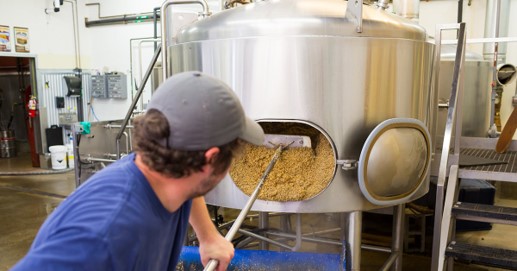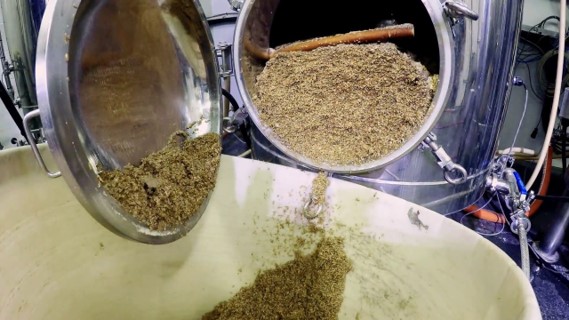A “Fermented Beverage Producer” is any facility which discharges wastewater to Austin Water’s collection system as a result of a process or function that includes:
- The fermentation of liquids at breweries, distilleries, cideries, meaderies, sakaguras, wineries, and other fermented beverage production facilities.
- The cleaning/sanitizing of equipment, vessels or production area used for the fermentation of liquids.
- Requirements for Fermented Beverage Producers
-

In accordance with Chapter 15-10 (Wastewater Regulations) of the Austin City Code, Austin Water’s Utility Compliance Services Division (UCSD) requires all Fermented Beverage Producers do the following:
- Complete an Application for a General Industrial User Wastewater Discharge Permit (Adobe PDF)
- Develop, submit, and maintain Best Management, Source Reduction, and Pollution Prevention Practices that include, at a minimum:
- Standard Operating Procedures (SOP) detailing how the facility will meet the pH (6.0-11.5), temperature (Less than 120F), and solids requirements as set forth in 15-10-22 (Specifically Prohibited Pollutants) of the Austin City Code.
- Log sheets documenting that the temperature and pH of each discharge has been recorded and met satisfactorily.
- Log sheets documenting the occurrence and measurement of each solid waste disposal event.
-
Complete the online Fermented Beverage Producers Supplementary Questionnaire. In Section 3 of the Questionnaire, you will be required to attach the General Industrial User Wastewater Discharge Permit Application and Best Management, Source Reduction, and Pollution Prevention Practices documentation referenced above.
Once the Questionnaire is submitted with the required attachments, a Pretreatment Compliance Specialist will review and follow-up to confirm receipt. If you have any questions about the information needed, please contact awfbp@austintexas.gov.
- Staying within pH, Temp, and Solid Discharges specified
-

It is vital that wastewater sent to Austin Water’s collection system stay within the requirements for pH, temperature, and solids discharges specified in the Austin City Code.
- Wastewater that is too acidic (below 6.0) or alkaline (above 11.5) can corrode the sewer collection system.
- High temperatures can inhibit vital biological processes at the wastewater treatment plants and cause premature wear on the collection system.
- Solids capable of settling can block or restrict flows in sewer lines resulting in overflows.
These discharge requirements are designed to lower the risk of damage to the collection system and reduce sewer overflows into sensitive watersheds.
- Best Management Practices
-
Developing best management, source reduction, and pollution prevention practices will not only help ensure you are in compliance with the City of Austin’s Wastewater Ordinance but helps protect our local environment and ultimately saves you money.
Due to the discharge of grains, yeast, trub/hops, and other materials used in fermenting processes, the wastewater from Fermented Beverage Producing businesses is typically more heavily concentrated with solids and organic matter than residential wastewater, making it more expensive to treat.
Of particular concern is Biochemical Oxygen Demand (BOD), Chemical Oxygen Demand (COD) and Total Suspended Solids (TSS). For the City of Austin, the “Normal Values” for each are:
- BOD – 200 mg/l
- COD – 450 mg/l
- TSS – 200 mg/l
Austin Water customers with wastewater exceeding any of the above levels are subject to monthly surcharge fees to help offset the extra energy and cost for the treatment plant.
The following Best Management Practices are recommendations to help Fermented Beverage Producers meet the pH (6.0-11.5), temperature (Less than 120F), and solids requirements as set forth in 15-10-22 (Specifically Prohibited Pollutants) of the Austin City Code. They may also help reduce surcharge fees associated with the extra strength wastewater typical of Fermented Beverage Producers.
Solids Management
Wastewater generated by Fermented Beverage producers typically has a high concentration of solids.
- Prevent spent grains and other solids from entering the drain as they can contribute to high surcharges and pipe blockages.
- Sweep or squeegee the floor and then dispose of collected materials before washing with water.
- Install appropriate screens, filters and/or baskets on floor drains to capture solids from going into the wastewater. Ensure employees do not routinely remove or bypass these screens.
- Capture & reuse yeast when possible as yeast can contribute to very high surcharges.
Control pH
In general, wastewater generated by Fermented Beverage Producers is acidic. However, cleaning processes can cause variable spikes. All Industrial Users must maintain compliance with the City of Austin’s pH discharge limits which specifically prohibits the discharge of an acid, alkali, or substance with a pH value lower than 6.0 or higher than 11.5 standard units, or that corrodes or damages the publicly owned treatment works (POTW).
- Adjust the pH of individual waste streams using tanks or totes.
- If feasible, install a sufficiently sized tank to collect wastewater from all operations for the purpose of self-neutralization, and if necessary, to adjust the pH using chemistry and sufficient mixing.
- DO NOT use City tap water to dilute or adjust pH of wastewater. This wastes water and is specifically prohibited by Austin City Code.
Control Temperature
Wastewater generated by Fermented Beverage Producers may be very high in temperature. All Industrial Users must maintain compliance with the City of Austin’s temperature discharge limits which specifically prohibits the discharge of “a substance causing heat in the POTW at a temperature of 120 degrees Fahrenheit”.
- Collect wastewater prior to discharge and allow hot wastewater to sit until cooled to below 120 degrees Fahrenheit.
- Blend hot wastewater streams with ambient/cool wastewater to below 120 degrees Fahrenheit.
- DO NOT use City tap water to adjust the temperature of wastewater. This wastes water and is specifically prohibited by Austin City Code.
Records
Austin Water requires all Fermented Beverage Producers to maintain logs or records documenting the temperature and pH of each wastewater discharge and logs documenting the off-site disposal of solid wastes including but not limited to grains, trub, grapes, or other fermenting by-products.
- Maintain records on site documenting your facility’s compliance with the requirements for a minimum of three (3) years.
- Maintain records including pH and temperature logs of wastewater discharges, logs of solids disposal events, and calibration logs of pH meter(s).
Product Losses/Off-Spec Product
Sending excessive amounts of high strength waste to the sewer can disrupt the sewer system and/or increase your high strength surcharge fees. Minimize the volume of unused and off-spec product discharged to the public sewer whenever possible.
In addition to collecting spent yeast, grains, hops and trub, collect the following high strength wastes and consider beneficial reuse or disposal off-site.:
- Off spec and unused product
- Tank heels and initial rinse of tanks
- Product & yeast lost in racking and transfer
- Product lost in filtering, bottling, and/or kegging
Chemical Storage & Spill Prevention
Accidental spills and discharges of chemicals can cause damage to the public sewer and may cause you to incur serious violations.
- Store all chemicals in secondary containment and ensure all chemical measuring and transferring is done over the containment tray.
- Regularly inspect all chemical storage for proper labeling and storage, integrity of secondary containment, and correct use of dispensing equipment.
- Consider developing a slug control plan and train employees to follow the plan.
Water Conservation
Since quantity of wastewater is a factor in surcharges, conserving water can not only benefit the environment, but save you money. Here are some tips to reduce water use:
- Monitor your water usage and wastewater discharge volumes; establish a baseline and set water saving goals.
- Use dry clean-up procedures prior to wet clean-up.
- Use water-efficient equipment, such as high-pressure nozzles, clean-in-place systems, and water brooms. Find alternatives to water-cooled chilling equipment.
- Pay attention to your water utility bill. A significant variance may indicate an overlooked leak.
Beneficial Reuse
When disposing waste offsite, consider beneficial reuse. Seek opportunities to turn your solids and high strength waste into compost, fertilizer, animal feed, energy, or other authorized beneficial reuse.
Resources
Forms and Resources
- Fermented Beverage Producers: Requirements and FAQs (Adobe PDF)
- Example of a Generic Fermented Beverage Producer SOP (Adobe PDF)
- Pretreatment Forms, Applications and Reports
- Austin City Code, Chapter 15-10 – Wastewater Regulations
- Austin Water's Annual Water Quality Report
- Austin Water Commercial Rebates

